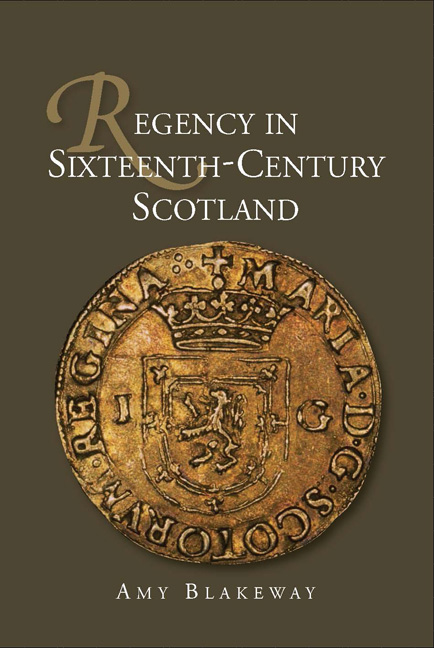Book contents
- Frontmatter
- Dedication
- Contents
- List of Figures and Tables
- Acknowledgements
- List of Abbreviations
- Timeline of Regents and Monarchs
- Introduction
- 1 Concepts of Regency
- 2 Concepts of Regency in Practice
- 3 Regency Finances
- 4 Households and Courts
- 5 Justice and Regency
- 6 Regency Diplomacy
- Conclusion
- Appendix 1 The Treasurer's Accounts
- Appendix 2 The Comptroller's Accounts
- Appendix 3 The Collectors of the Thirds' Accounts
- Appendix 4 Justice Ayres in Sixteenth-Century Scotland
- Bibliography
- Index
2 - Concepts of Regency in Practice
Published online by Cambridge University Press: 05 May 2015
- Frontmatter
- Dedication
- Contents
- List of Figures and Tables
- Acknowledgements
- List of Abbreviations
- Timeline of Regents and Monarchs
- Introduction
- 1 Concepts of Regency
- 2 Concepts of Regency in Practice
- 3 Regency Finances
- 4 Households and Courts
- 5 Justice and Regency
- 6 Regency Diplomacy
- Conclusion
- Appendix 1 The Treasurer's Accounts
- Appendix 2 The Comptroller's Accounts
- Appendix 3 The Collectors of the Thirds' Accounts
- Appendix 4 Justice Ayres in Sixteenth-Century Scotland
- Bibliography
- Index
Summary
The change in conceptions of regency outlined in chapter one, from an inherited right and duty to an office bestowed by election, had implications for the practicalities of rule. A small but significant example of the way in which changing understandings of regency affected practice can be seen in the sederunt lists of privy council meetings, which recorded the individuals in attendance in order of precedence. During majority rule, the name of the monarch attending the council was written above the word ‘sederunt’, indicating the monarch's superior, and separate, status. During the minorities of James v and Mary, Queen of Scots, the regent's name was inscribed in the same position. From Moray's regency onwards, the regent's name appeared below the word ‘sederunt’, integrated as the first amongst equals in the list of councillors, reflecting new understandings of regency as an elective office. Practice during the minority in due course influenced that of James vI's personal rule, when the king's name appeared below the title ‘sederunt’, although elevated to the line above the councillors.
Whilst the changing format of sederunt lists provides a microcosmic example of the way in which theory informed practice, comparable changes can be seen throughout the political system. In particular, as the format of sederunt lists shows, the relationship between the regent and the council discernibly altered. The development of notions of elective regency also affected the inauguration ceremonies held to install regents in their office. We shall first consider the changes to inauguration ceremonies, before moving on to consider the regent-council relationship. The third major section of this chapter examines how regents lost office, and the related issue of the age of monarchical majority. The chapter concludes by considering the practice of royal acts of revocation, whereby the crown exercised its right to reverse property transactions completed before the monarch's twenty-fifth birthday and deemed damaging to the royal patrimony.
- Type
- Chapter
- Information
- Regency in Sixteenth-Century Scotland , pp. 54 - 88Publisher: Boydell & BrewerPrint publication year: 2015



